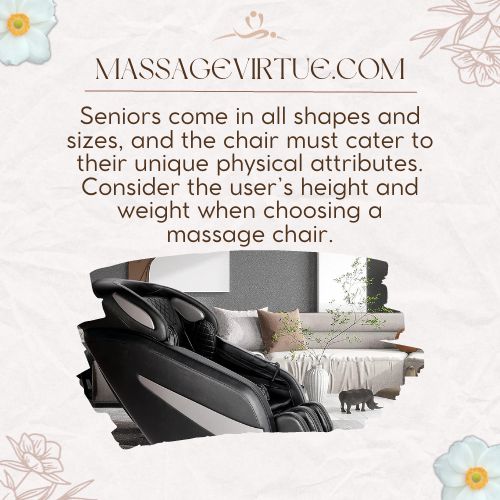Massage chairs have become increasingly important in modern life, offering a convenient and accessible way to experience the therapeutic benefits of massage in the comfort of one’s own home or office.
However, to truly make the most of a massage chair and unlock its full potential, it is crucial to have a comprehensive understanding of its various parts and functionalities.
In this article, we will delve into the anatomy of massage chairs, exploring the key components that contribute to their functionality.
Anatomy of a Massage Chair
The key massage chair parts are divided into two basic anatomy; external and internal structure.
1. External Structure
Frame and Chassis:
The frame and chassis form the foundation of a massage chair, providing structural integrity and support.
Usually made from durable materials like steel or reinforced plastic, the frame ensures the chair can withstand the weight of users and the pressure applied during massages.
A robust frame enhances the chair’s stability and longevity, making it capable of enduring regular use.
Upholstery and Padding:
The upholstery and padding of a massage chair play a vital role in user comfort and relaxation.
High-quality, plush padding ensures a comfortable seating experience, allowing users to enjoy their massages without feeling discomfort or pressure points.
The upholstery material, often synthetic leather or fabric, should be breathable and easy to clean for hygiene purposes.
Armrests and Controls:
Massage chairs come equipped with ergonomic armrests, providing a comfortable place for users to rest their arms during a massage session.
The armrests are typically cushioned to add to the overall comfort of the user.
Additionally, the control panel is an essential external feature, allowing users to interact with the chair, select massage programs, adjust intensity levels, and control specific functions.
2. Internal Components
Motors and Actuators:
The motors and actuators are the workhorses of a massage chair, responsible for creating the various massage motions and movements.
Each motor corresponds to a specific massage function, such as kneading, rolling, tapping, or Shiatsu.
Actuators control the range and intensity of motion for each massage technique, allowing users to customize their massage experience.
Airbags and Compression Systems:
Airbags are inflatable components strategically placed within the massage chair.
When inflated and deflated, they apply pressure to different parts of the body, simulating the sensation of a human hand pressing on the muscles.
The compression system uses the airbags to deliver rhythmic squeezing and compressing motions, improving blood circulation and reducing muscle tension.
Heating Elements :
Heating elements in a massage chair provide therapeutic heat, adding an extra layer of relaxation and relief during a massage session.
These elements are usually placed strategically in the backrest, seat, and leg rest areas.
Key Massage Chair Parts
A massage chair consists of several essential parts that work together to provide various massage techniques and deliver a relaxing and therapeutic experience.
Let’s delve into each key massage chair part:
1. Rollers and Massage Mechanisms:
Rollers are one of the fundamental components of a massage chair, responsible for replicating the kneading and rolling motions used by human hands during a massage.
These rollers move up and down the backrest, imitating the hands of a skilled masseuse.
Some advanced massage chairs offer 2D, 3D, or 4D rollers, allowing for greater control over the intensity and depth of the massage.
- 2D Rollers: Move up and down and side to side, providing a basic massage experience.
- 3D Rollers: In addition to up-and-down and side-to-side movements, they can protrude in and out to reach deeper layers of muscles.
- 4D Rollers: Similar to 3D rollers but with the added ability to adjust the speed and intensity of the massage for a more customizable experience.
2. Airbags and Compression Systems:
Airbags are inflatable chambers positioned in various areas of the massage chair parts, including the sides, seat, arms, and legs.
When activated, these airbags inflate and deflate to apply gentle pressure and compression to different body parts.
This compression massage technique helps relieve muscle tension, improving blood circulation, and reducing swelling.
3. Heating Elements:
Heating elements are strategically placed within the massage chair and emit gentle warmth during the massage session.

The therapeutic heat helps to relax muscles, promote blood flow, and alleviate tension, enhancing the overall effectiveness of the massage.
4. Control Panels and User Interfaces:
Massage chairs feature intuitive control panels or user interfaces that allow users to adjust massage settings, select pre-set programs, control the intensity, and target specific areas for massage.
Some modern massage chairs even offer smartphone app integration, providing seamless control through mobile devices.
5. Motors and Actuators:
Motors are responsible for powering the movement of rollers and other massage mechanisms in the massage chair.
While, actuators control the range and intensity of motion, allowing for precise adjustments to create customized massage experiences.
6. Frame and Chassis:
The frame and chassis form the structural backbone of a massage chair, providing stability, support, and durability.
Typically constructed from robust materials like steel or reinforced plastic, the frame serves as the foundation on which all other components are mounted.
The frame’s design ensures that the massage chair can safely accommodate users of different sizes and weights.
The chassis refers to the framework that houses the internal components of the massage chair.
It serves as a protective enclosure and ensures that all parts are securely held in place. The chassis also aids in distributing the user’s weight evenly across the frame, preventing undue stress in specific areas.
7. Upholstery and Padding:
The upholstery and padding of a massage chair play a crucial role in ensuring user comfort during a massage session.
High-quality upholstery materials, such as synthetic leather or durable fabric, cover the massage chair’s surface, providing a smooth and comfortable seating surface.
The choice of upholstery material affects the chair’s overall appearance and ease of maintenance.
The padding within the massage chair is responsible for providing a cushioned and plush feel to the user.
High-density foam or other soft materials are used to create a comfortable seating experience.
Proper padding ensures that users do not experience discomfort or pressure points during their massage sessions, enhancing relaxation and overall satisfaction.
Maintenance and Care for Massage Chair Parts
1. Cleaning and Upholstery Care:
Regular cleaning and proper upholstery care are essential to maintain the hygiene, appearance, and longevity of massage chair parts.
Here’s a detailed explanation of each aspect:
Cleaning:
- Surface Cleaning: Wipe down the exterior surface of the massage chair with a soft, damp cloth to remove dust, dirt, and spills. Avoid using abrasive or harsh cleaning agents that could damage the upholstery.
- Crevice Cleaning: Use a vacuum cleaner with a soft brush attachment to clean the crevices and hard-to-reach areas of the chair, ensuring no debris or dust accumulates in these spots.
- Leather Upholstery: For massage chairs with leather upholstery, use a mild leather cleaner and conditioner to keep the material supple and free from cracks. Follow the manufacturer’s recommendations for specific leather care products.
- Fabric Upholstery: If the massage chair has fabric upholstery, check the care instructions for recommended cleaning methods. Some fabric covers may be removable and machine washable, while others may require spot cleaning with a gentle fabric cleaner.
Upholstery Care:
- Avoid Direct Sunlight: Keep the massage chair away from direct sunlight to prevent fading and discoloration of the upholstery over time.
- Prevent Spills: Be cautious with food and drinks while using the massage chair to avoid spills that could stain the upholstery.
- Use a Cover: Consider using a removable, washable cover to protect the massage chair’s upholstery from everyday wear and tear.
2. Lubrication of Mechanical Components:
Proper lubrication of the massage chair’s mechanical part ensures smooth and noise-free operation.
Here’s how to go about it:
- Check the Manufacturer’s Guidelines: Refer to the user manual or the manufacturer’s guidelines to identify the specific lubrication points and recommended lubricant type for your massage chair model.
- Use High-Quality Lubricants: Purchase a high-quality lubricant recommended by the manufacturer to ensure compatibility with the massage chair’s components.
- Lubricate at Regular Intervals: Follow the maintenance schedule outlined in the user manual to know when to apply lubrication. It is generally recommended to lubricate moving parts every three to six months, depending on usage.
- Apply Lubricant Carefully: Apply the lubricant sparingly and precisely to the designated lubrication points, ensuring it reaches the internal mechanisms effectively.
3. Troubleshooting Common Issues:
While massage chairs are designed for durability and reliability, occasional issues may arise.
Understanding how to troubleshoot common problems can save time and effort. Here are some common massage chair issues and potential solutions:
- Unresponsive Control Panel: Check if the massage chair is properly plugged into a power source. Ensure the power cord is securely connected to the outlet. If the control panel remains unresponsive, there might be an electrical issue and professional assistance may be required.
- Abnormal Noises: If the massage chair makes unusual sounds during operation, check for any loose screws or foreign objects stuck in the chair’s mechanisms. Tighten any loose components and remove any debris that might be causing the noise.
- Uneven or Intense Massage: If the massage chair is providing an uneven or excessively intense massage, adjust the intensity settings using the control panel. If the problem persists, it could be due to an issue with the rollers or airbags. In such cases, contacting the manufacturer or a professional technician is recommended.
- Massage Techniques Not Working: If specific massage techniques are not functioning correctly, reset the massage chair to its default settings and reselect the desired program. If the issue persists, there might be a malfunction with the massage chair’s internal components, requiring professional inspection and repair.
Conclusion
In conclusion, comprehending massage chair parts empowers users to unlock the full potential of these therapeutic furniture pieces.
The combination of high-quality components, precise engineering, and user-friendly controls ensures that massage chairs cater to a diverse range of wellness needs.
From stress relief to pain reduction, improved circulation to enhanced relaxation, the synergy of massage chair parts delivers a transformative and rejuvenating massage experience, all within the confines of a comfortable and convenient massage chair.
FAQs
1. What are the key massage chair parts that contribute to the massage experience?
Massage chair parts that significantly impact the massage experience include rollers (2D, 3D, 4D), airbags and compression systems, heating elements, Shiatsu massage nodes, and tapping and percussion mechanisms.
2. How often should I clean my massage chair’s upholstery?
It is recommended to clean the massage chair’s upholstery regularly to maintain hygiene and appearance.
Wipe down the surface with a soft, damp cloth as needed, and conduct thorough crevice cleaning with a vacuum attachment periodically.
3. How do I troubleshoot common issues with my massage chair?
For common issues like unresponsive control panels or abnormal noises, first check the power source and connections.
Tighten loose screws and clear any debris stuck in the chair’s mechanisms. If the problem persists, seek professional assistance or contact the manufacturer for support.
4. What are the safety measures to keep in mind while using a massage chair?
Safety measures include adhering to the chair’s weight and usage limits, unplugging the chair when not in use, and avoiding overloading electrical circuits.
5. How often should I lubricate the mechanical components of my massage chair?
It is generally recommended to lubricate the massage chair’s mechanical components every three to six months, depending on usage.
Refer to the user manual or manufacturer’s guidelines for specific lubrication points and recommended lubricant types.
6. Are massage chair parts covered by warranty?
The warranty coverage for massage chair parts may vary depending on the manufacturer and model.
It is essential to review the warranty terms before purchasing a massage chair to understand the extent of coverage and any specific conditions for parts replacement or repairs.

